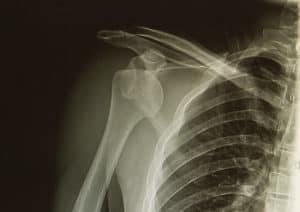
If the damage wasn’t done to the ligaments and soft tissues during the dislocation, doctors would most likely suggest resting the shoulder as well as taking anti-inflammatories to manage the pain and swelling.
Once the pain has been controlled, and swelling has resolved, rehabilitation can begin to increase range of motion and rebuild muscle tone and strength. With every injury, recovery depends on the severity of the injury; however, with shoulder injuries, most patients recover within a few weeks or even months.
What Is Closed Reduction?
For most dislocations, shoulders can be repositioned without surgery using a closed reduction procedure. The doctor will administer an anesthetic to help minimize the pain and then manually reposition the humerus into the shoulder socket.
Almost immediately following the repositioning of the shoulder, the pain will diminish. The procedure from start to finish takes about 30 minutes, and following a follow-up x-ray, patients can return home.
If dislocations are frequent, the soft tissues around the shoulder may be damaged, and the doctor may order an MRI to see if the humerus is firmly in the socket. If the MRI determines that there is damage present, surgery may be discussed to repair the damaged tissues and ligaments surrounding the joint.
Immobilization and Icing
Although the excruciating pain may subside following the positioning of the shoulder, it will continue to be sore for several days. Applying ice and resting the shoulder for a few days following the dislocation is best for optimal recovery.
A sling is often placed on the arm to provide support to the shoulder for a period of four to six weeks to allow the muscles and soft tissues to heal correctly.
When applying ice, only use the ice for 15-20 minutes, three times a day to promote healing and reduce swelling.
Pain Relief Medication
Pain may still be present following the repositioning of the shoulder, and the dull, aching pain should be managed through the use of anti-inflammatories to aid in reducing that pain. Many of these medications can be found over the counter, such as ibuprofen. However, long term use of these medications are not advised as side effects
Physical Therapy
Once the swelling and pain have been managed, physical therapy can begin. Teaming up with physical therapy will allow for the muscles to have a chance to strengthen, stability can improve, and preventative measures can also be learned.
Our Atlanta orthopedic doctors recommend that patients with shoulder dislocations attend four to six weeks of physical therapy sessions following a shoulder dislocation. This therapy plan promotes healing as well ensures that the muscles are strengthening to prevent future dislocations. Range of motion, as well as pain management, are also added benefits to this effective therapy method.
Physical therapists also offer massage therapy, heat and ice therapies, and acupuncture as a part of a plan to enhance your overall wellbeing as you recover.
If you are interested in learning more about our approach to dislocated shoulder treatment, our Atlanta orthopedic doctors are experienced in diagnosing and treating this painful condition. Our ultimate goal is to diminish your pain and ensure that your shoulder is properly aligned and to provide education on strength training exercises to help prevent future occurrences. If you would like to learn more about how we can help you reach optimal recovery, contact us today at (404) 855-2141.
